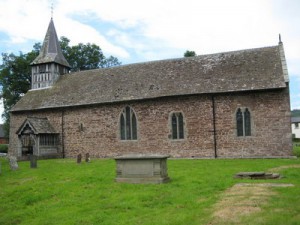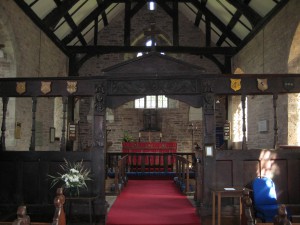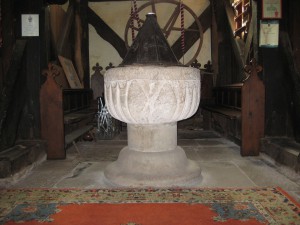The church of St. Bartholomew is of Norman origin
During the ministry of a Rev. Beresford Lowther, vicar of this church from 1836 to 1868, a great deal of alterations were carried out – he was a very wealthy man and owned a house in London as well as living in the Rectory at nearby Turnastone. During these renovations which seem to have been rather detrimental to the building, many monuments and shields were destroyed or obliterated by whitewash, including some for the families of Hoskyns, Somerset, Russell, Boughton, Morgan, Parry and Vaughan, who were all land owners in the Golden Valley. Some monuments did survive including that in the memory of Lord Arthur Somerset who died 1st June 1743 aged 72, but it is rather sad that there are two arched recesses which must surely have housed tombs………..there is no known record of who these belonged to, or indeed what happened to the tombs.
The Rev. Skeffington Hume Dodgson was vicar from 1895 until around 1910, and he was the brother of Lewis Carroll of Alice in Wonderland fame.
Font
The font at St. Bartholomew has a Norman bowl made from local limestone. The cone cover might be 18th century
Memorials
Below the 17th century chancel screen is a carved board “Heare below ly the body of Thomas Hill ande Margret his wife whose children made this skryne”.
Some of the Shields were restorable, and others were later added – these are the names on some of them:
Lady Arthur Somerset d. 1724, wife of Lord Arthur Somerset of Poston, youngest son of Henry 1st Duke of Beaufort.
Lady de la Revere Morgan, wife of Sir Thomas Morgan, owner of Chanstone.
Blanche Brydges of Tyberton
Brabazon Lowther
Rev. John Salter
Col. Mountjoy Martin
Rev. Archer Clive of Whitfield
Herbert Howoth of Whitehouse
Francis Appleyard
Sir Edward Boughton Bart. of Poston
Rowland Vaughan of Whitehouse dated 1613
George Lowther
Laura Lowther
Lord Saye and Sele
Lee Warner of Tyberton
John Parry of Poston
Sir William Russell, Bart. 1712
Lord Arthur Somerset of Poston
James Webb of Monnington
Most of the old gravestones in the churchyard have weathered so badly that they are unreadable, but in the mid nineteenth century much harder stone was introduced and these stones have survived well.
It is a delight to note that some of the churchyard has been left largely unattended as a haven for wildlife.


